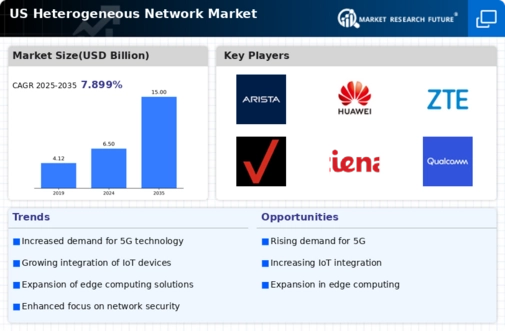Integration of 5G Technology
The rollout of 5G technology is poised to significantly impact the heterogeneous network market. With its promise of ultra-low latency and high data transfer rates, 5G is expected to revolutionize various sectors, including healthcare, transportation, and entertainment. In the US, the 5G infrastructure investment is anticipated to exceed $275 billion by 2025, highlighting the urgency for network operators to adapt. The integration of 5G into existing heterogeneous networks allows for seamless connectivity across diverse devices and platforms, enhancing user experiences. As more devices become 5G-enabled, the demand for heterogeneous network solutions that can efficiently manage and optimize these connections will likely increase. This integration not only supports the growing number of connected devices but also fosters innovation in applications that rely on real-time data processing.
Rising Cybersecurity Concerns
As the heterogeneous network market expands, so do the cybersecurity challenges associated with it. The increasing frequency of cyberattacks has prompted organizations to prioritize network security measures. In the US, cybersecurity spending is projected to reach $200 billion by 2024, reflecting a growing recognition of the need for robust security frameworks. Heterogeneous networks, which often incorporate various technologies and devices, can present unique vulnerabilities. Therefore, businesses are investing in advanced security solutions that can protect their networks from potential threats. This focus on cybersecurity not only safeguards sensitive data but also enhances consumer trust in network services. As organizations continue to navigate the complexities of cybersecurity, the demand for secure heterogeneous network solutions is likely to rise, further driving market growth.
Emergence of Smart Cities Initiatives
The development of smart cities is significantly influencing the heterogeneous network market. As urban areas increasingly adopt smart technologies, the demand for interconnected networks that can support various applications is growing. In the US, investments in smart city initiatives are projected to reach $100 billion by 2025, underscoring the importance of efficient network infrastructure. Heterogeneous networks play a crucial role in enabling the integration of smart devices, sensors, and data analytics platforms, facilitating improved urban management and service delivery. This trend not only enhances the quality of life for residents but also presents opportunities for businesses to innovate and expand their offerings. As smart city projects continue to gain momentum, the heterogeneous network market is likely to benefit from increased investments and technological advancements.
Growing Demand for High-Speed Connectivity
The heterogeneous network market is experiencing a surge in demand for high-speed connectivity solutions. As businesses and consumers increasingly rely on data-intensive applications, the need for robust network infrastructure becomes paramount. In the US, the market for high-speed internet services is projected to reach approximately $100 billion by 2026, indicating a strong growth trajectory. This demand is driven by the proliferation of streaming services, online gaming, and remote work solutions, all of which require reliable and fast internet connections. Consequently, service providers are investing in heterogeneous network technologies to enhance their offerings, ensuring they can meet the evolving needs of their customers. This trend is likely to continue, as the appetite for high-speed connectivity shows no signs of abating, thereby propelling the heterogeneous network market forward.
Increased Focus on Network Management Solutions
The heterogeneous network market is witnessing a heightened emphasis on effective network management solutions. As networks become more complex due to the integration of various technologies, the need for sophisticated management tools has become evident. In the US, the network management software market is expected to grow at a CAGR of 12% through 2025, indicating a robust demand for these solutions. Organizations are seeking tools that can provide real-time monitoring, analytics, and optimization capabilities to ensure seamless network performance. This trend is particularly relevant as businesses strive to enhance operational efficiency and reduce downtime. By investing in advanced network management solutions, companies can better navigate the intricacies of heterogeneous networks, ultimately leading to improved service delivery and customer satisfaction.























Leave a Comment